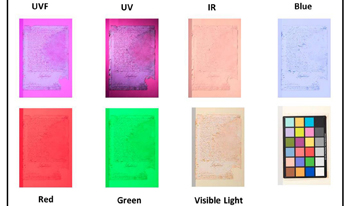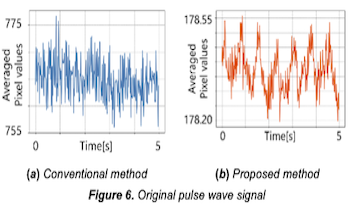
Multispectral Imaging has become an indispensable tool for Cultural Heritage materials and objects analyzing, documenting, and visualizing. This study delves into applying this technique to an 18th-century illuminated manuscript at the Minas Gerais Public Archive, Brazil. Currently undergoing restoration intervention at The Federal University of Minas Gerais, the manuscript exhibits faded writing due to moisture, and the application of multispectral imaging (UV, Visible, and IR) with seven different wavelengths proves highly effective in recovering lost information. The light source was provided from LED and Halogen Lamp, and the result shows a very clear text on the manuscript after the digital processing by ImageJ and PCA. The Minas Gerais Public Archive, established in 1895, plays a vital role in safeguarding the state's documentary and historical heritage. It was the first-time multispectral imaging was applied to cultural objects in Minas Gerais.

In this paper, we propose a noise-robust pulse wave estimation method from NIR video. Pulse wave estimation in the near-infrared region is expected to be applied to non-contact monitoring in dark areas. Conventional method cannot consider noise when performing estimation, so the accuracy of pulse wave estimation in noisy environment is not very high. This may adversely affect the accuracy of heart rate and other data obtained from pulse waves. Therefore, the objective of this study is to perform pulse wave estimation robust to noise. The Wiener estimation method was used in this study. The Wiener estimation method is a simple linear computation that can consider noise. The proposed method is expected to enable non-contact and accurate estimation of pulse wave from near-infrared video images. Experimental results show that the proposed method estimates the pulse wave more robustly to noise than the conventional method. Furthermore, the heart rate was estimated from the estimated pulse wave and the proposed method was able to obtain a value closer to the ground truth.

By using a new materials system, we developed invisible passive infrared markers that can take on various visual foreground patterns and colors, including white. The material can be coated over many different surfaces such as paper, plastic, wood, metal, and others. Dual-purpose signs are demonstrated where the visual foreground is for human view while the infrared background is for machine view. By hiding digital information in the infrared spectral range, we can enable fiducial markers to enter public spaces without introducing any intrusive visual features for humans. These fiducial markers are robust and easy to detect using off-the-shelf near infrared cameras to assist robot positioning and object identification. This can reduce the barrier for low-cost robots, that are currently deployed in warehouses and factories, to enter offices, stores, and other public spaces and to work alongside with people.